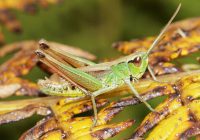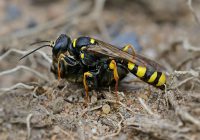Dr Phil Smith’s Wildlife Notes
September 2014
Autumn rains usually start to recharge our wetlands in September. Not so this month which produced only 8% of average rainfall for the region, being the driest September in the UK since records began in 1910. Many sand-dune slacks and scrapes dried up but, on 5th, there was still enough water at Sands Lake to attract large numbers of Migrant Hawkers, while a pair of Ruddy Darters enlivened a nearby scrape, the female characteristically laying eggs on the dry fringes. These will hatch when they are flooded by rising water-levels, assuming we eventually get some rain. A short walk north brought us to the restored ponds of slack 47 where there were more Migrant Hawkers and another Ruddy Darter. Other insects here included brightly coloured Buff-tip moth caterpillars on willow and a striking Bronze Shieldbug. Reminders of autumn included a Kingfisher, a Short-eared Owl and six Wheatears on the shore, all birds on the move. The following day, perhaps the same Kingfisher was at Sands Lake, where 40 Tufted Ducks were also new arrivals.
Shieldbugs are an interesting group, relatively easy to identify and attractive subjects for photography. Checking their distribution on the internet showed that these insects are relatively poorly recorded in our area, so I quickly put together a list of all my observations. It turned out I had seen (and photographed) nine species on the Sefton Coast, both Bronze and Blue Shieldbugs being new to the district.
On 3rd, I joined Trevor Davenport for a trip to Highfield Moss, a peat-bog near Warrington which is now a Lancashire Wildlife Trust nature reserve. It is renowned for dragonflies and despite rather cloudy conditions we saw plenty of Black Darters and Common Hawkers. Another speciality is the Meadow Grasshopper which is ubiquitous further south in Britain but in our region seems largely confined to peatlands. It is abundant at Highfield but I have never found it on the Sefton Coast. We were also intrigued by several black-and-yellow digger wasps which were stocking nest-holes in a clay bank with small flies as food for their larvae. They turned out to be the widespread Mellinus arvensis.
The tenth anniversary of Freshfield Dune Heath Nature Reserve was combined with the Sefton Coast Festival on 7th in a major event attracting over new 70 visitors. I led a guided walk with 25 participants. Not many flowers were to be seen but the insects were good with Ruddy and Common Darters in the hand for comparison, while Gorse and Birch Shieldbugs also entertained. Open areas of heathland produced Mottled Grasshoppers and the Heath Assassin Bug. A “Bioblitz” recorded 295 species, including over 60 new ones for the reserve.
Readers of these notes will know of my enthusiasm for rare hybrid willows, the Sefton dunes being renowned for them. Patricia Lockwood helped me record, measure and label no less than 78 bushes of Salix × friesiana at a particular hotspot, the Devil’s Hole, Ravenmeols. This plant is known from only nine other places in Britain. Salix × doniana is even rarer, so I was ecstatic to find a sapling of this distinctive hybrid, adding to one spotted two years ago. Last February, nine large bushes of Salix × friesiana were cut down by mistake during a scrub clearance exercise in a Birkdale slack, several being stump-treated. On 12th, I went back to check their fate, being delighted to find all had survived and regrown by up to 2m. Just as pleasing were six new bushes of the same hybrid.
Late in the month, Patricia Lockwood joined me at Marshside to check the Glassworts (Salicornia) on the saltmarsh, this being the best time of year to see them. Purple, Common and Long-stalked Glassworts were in great abundance, while a few specimens of the scarce Yellow Glasswort were also noted. We hoped to find the extremely rare Glaucous and Shiny Glassworts but, as they are really difficult to identify, their presence was not confirmed. Marshside is a wonderful place for saltmarsh plants, perhaps meriting an organised field visit next year.




